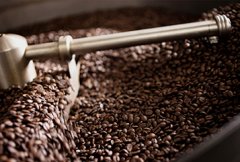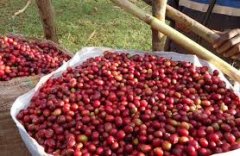Price of Honduran Coffee how to drink Honduran Coffee

Qianjie knows that for many coffee fans, there is nothing to have a cup of coffee anytime and anywhere during the break! It can not only relax the body and mind, but also refresh and help. It is a refueling drink for office workers. But to make fresh hair, you need not only appliances, but also technology, which is a bit of a luxury for them! Nothing, there is a hanging ear bag, to ask what the ear tastes good, of course.

Honduras
Honduras is located in the north of Central America, facing the Caribbean Sea to the north, the Gulf of Fonseca in the Pacific Ocean to the south, Nicaragua and El Salvador to the east and south, and Guatemala to the west, mostly mountains and plateaus.
There are 280000 hectares of coffee plantations in Honduras, mainly small coffee plantations, most of which are less than 3.5ha. These coffee plantations account for 60% of all coffee production in Honduras.
In the coffee garden, because the planting area belongs to the mountain area, people pick coffee beans by hand, and then process them carefully in order to produce better quality coffee beans. Honduras collects 3 million bags of coffee every year and provides you with multi-quality coffee. It has become one of the top ten coffee exporters in the world.
Honduras coffee can be divided into six major producing areas, mainly located in the western and southern regions of Copan, Opalaca, Montecillos, Comayagua, Agalta Tropical and El Paraiso. The average height of high-quality products is more than 1100 meters above sea level. 69% of the coffee grown in these areas is HG, and 12% is SHG,19% and CS.

| | Masaguara (Masaguara) |
Masaguara is a municipality in the province of Intibuc á in Honduras, south of the Jes ú sdeOtoro valley, surrounded by mountains and hills, focused on coffee growers and the main engine of the local economy. The area corresponding to the valley is dedicated to growing basic grains and livestock. The origin of his name: according to Mr. AlbertoMembreo's "indigenous place name", Masaguara means "place with deer".

| | Variety (Kaddura, Kaduai, Pacas) |
Kaddura, a natural variety of bourbon, was discovered in Brazil in 1937. Its tree is not as tall and shorter as bourbon. Due to inheriting the blood of bourbon, the resistance is relatively weak, but the yield is higher than that of bourbon. Although found in Brazil, Kaddura is not suitable for growing in Brazil, so it is not planted on a large scale in Brazil, but is popular in Central and South America, such as Colombia, Costa Rica and Nicaragua.
Kaduai is an artificial hybrid of Kaddura and Mondu Novo. Kaduai has a good ability to resist natural disasters, especially wind and rain. Kaduai tree species are relatively low, compared with other coffee trees, the fruit of Kaduai is stronger and harder to pick, and the fruit is both red and yellow.

Pacas is a natural variety of bourbon. Like other widely cultivated low-bourbon varieties, Pacas is a single gene mutation. It is low mainly because the coffee tree has a small head and has high and low yield potential. It can be mixed with other fruits and other plants to increase the yield of coffee cherries.
The variety was found in 1949 on a farm of the Pacas family in the Santa Ana region of El Salvador. In 1960, the Salvadoran Coffee Institute (ISIC) began a pedigree selection project for Pacas (through successive generations of individual plant selection, also known as individual plant selection). It is popular in Central America and widely cultivated in El Salvador, accounting for about 25% of its production. In 1974, the Honduran Coffee Institute introduced this variety and planted it in Honduras.

| | handling method |
Fine washing whisky Shirley barrel fermentation treatment is that the freshly picked coffee fruits are carefully washed, then put into mature whisky oak barrels to ferment at a low temperature for 30-40 days (about 15-20 ℃), and then dry in the shade.
"Sherry barrel" is used as an aging barrel by the Sherry winery in the whisky industry. Sherry is a famous fortified wine produced in the sunny Jerez region of southern Spain. Sherry must be aged through the Solera system (Solera System) in the process of making sherry.
Solera system essentially refers to the process of mixing sherry of different ages after sherry is fortified. In the Solera system, all the barrels are stacked according to the vintage, with the oldest sherry at the bottom and the youngest sherry at the top, extracting part of the wine from the bottom barrel each year for bottling and sales, and then extracting the appropriate proportion from the upper barrel to replenish it, which is what makes sherry unique.

| | represents coffee beans |
[Shirley, Honduras]
Country: Honduras
Producing area: Masaguara
Manor: Moca Manor
Altitude: 1500-1700m
Variety: Kaddura, Kaduai, Pacas
Treatment: fine washed whisky Shirley barrel fermentation
Front street coffee Honduras Shirley coffee cup test
| | recommended rushing method: hang up the ear |
Many friends ask, do you want to stew your ears? Answer: both are OK, but the effect is slightly different.

[no steaming]
Trickle filter central water injection /
Parameters: 1 15; water temperature 91 ℃; 10g/ package; extraction time 1 minute; total extraction water 150g
Flavor: vanilla, berries, chocolate, overall coffee flavor is very light, taste clean.
Immersion central water injection /
Parameters: 1 15; water temperature 91 ℃; 10g/ package; total extraction time 2 minutes; total extraction water 150g
Flavor: vanilla, honey, berries, chocolate, juicy, light taste.
Summary of non-stuffy steaming
Through the comparison of these two ways, although the trickle filter has a flavor, the filter paper has better exhaust, fast flow rate and short extraction time, and many substances of the coffee itself are not extracted, so it is very light as a whole; the soaking type is to soak the coffee in water to achieve the taste you want in 2 to 3 minutes.

[steaming]
Trickling filter type one-cut water injection
Parameters: 1 15; water temperature 91 ℃; 10g/ package
Technique: 26g water injection steaming 30s, then 150g water injection stop, the time is 1cm 39% 34 ".
Flavor: vanilla, honey, berries, chocolate, fermented wine, soft acidity on the whole and obvious sweetness of honey on the finish.
Immersion type one-cut water injection
Parameters: 1:15, water temperature 91 ℃, 10g/ package
Technique: water injection 20g steaming 30s, then water injection 150g stop, the time is 2 minutes 39 percent 00 ".
Flavor: vanilla, honey, berries, chocolate, slightly lower honey sweetness.

Trickle filter sectional water injection
Parameters: 1Ru 15; Water temperature 91 ℃, 10g/ package
Technique: steam with 20g water for 30s, then inject water to 100g, see powder bed and then injection to 150g, the time is 1mm 39% 40 ".
Flavor: vanilla, honey, berries, chocolate, honey, fermented wine, obvious flavor level.
Immersion segmented water injection
Parameters: 1Ru 15; water temperature 91 degrees; 10g/ package
Technique: after steaming 25g for 30s, water was injected to 100g, then the powder bed was reinjected to 150g, and the time was 2cm / 390g.
Flavor: vanilla, honey, berries, chocolate, honey, fermented wine, mellow taste.
A summary of steaming

In the steaming part, the editor chose [trickling one-cut water injection-immersion one-knife water injection] VS [trickling filter segmented water injection-immersion segmented water injection] after steaming, the coffee particles after exhaust gas can be evenly absorbed and saturated, making the subsequent extraction more uniform, even if different extraction methods or techniques are used, the flavor of coffee is more abundant. Relatively speaking, the drip filter type tends to the acid flavor, and the coffee flavor level is relatively rich and distinct, while the immersion type tends to the flavor of nuts and chocolate, mainly through the soaking of water, so that these macromolecules like nuts, chocolate are more extracted to cover the small molecules of fruit acid that are easy to be extracted by water, and the overall taste of coffee is more mellow and balanced.
| do you want to soak the coffee in the cup?
At the beginning of brewing, most of the flavor substances extracted from coffee powder are fruit acid and floral flavor, then to nuts and chocolate, and finally to sweetness, while the concentration is gradually decreasing.
When we soak the ear into the cup to extract, there are already more substances extracted at the beginning in the liquid soaked in the ear bag, and the concentration difference is relatively small, then there will be fewer macromolecules such as nuts that can be extracted.
Moreover, when the ratio of powder to water is the same, the soaking extraction will drink more full-bodied and mellow than the non-soaking extraction cup. The editor thinks that this is because the overall extraction effect of immersion extraction is more complete and uniform. The extraction rate will be higher than that of non-soaking extraction, but because of the high concentration, other flavors will be more difficult to perceive, so the fruit acid is more obvious to drink.
Important Notice :
前街咖啡 FrontStreet Coffee has moved to new addredd:
FrontStreet Coffee Address: 315,Donghua East Road,GuangZhou
Tel:020 38364473
- Prev

Notes on the flavor of Honduran coffee roasting suggestions on roasting and brewing of Honduran coffee
For professional baristas, please follow the coffee workshop (Wechat official account cafe_style) (Tim's flavor notes) as usual, we separate different selection dates and varieties of coffee. After the harvest is finished, we taste all the batches and choose the best. The number of different batches will vary greatly, and some batches may be as small as one or two bags. For
- Next

Flavor description of El Salvador Honey treated Coffee introduction to HIU Cajamarca Farm
For the exchange of professional baristas, please pay attention to the coffee workshop (Wechat official account cafe_style) El Salvador honey processing HIU Cahamaka (Cajamarca) farm El Salvador is the smallest and most densely populated country in Central America, with rich natural ecology and species diversity, and coffee beans have a long history. Coffee was grown as early as 1740 as staple crops in most areas.
Related
- Does Rose Summer choose Blue, Green or Red? Detailed explanation of Rose Summer Coffee plots and Classification in Panamanian Jade Manor
- What is the difference between the origin, producing area, processing plant, cooperative and manor of coffee beans?
- How fine does the espresso powder fit? how to grind the espresso?
- Sca coffee roasting degree color card coffee roasting degree 8 roasting color values what do you mean?
- The practice of lattes: how to make lattes at home
- Introduction to Indonesian Fine Coffee beans-- Java Coffee producing area of Indonesian Arabica Coffee
- How much will the flavor of light and medium roasted rose summer be expressed? What baking level is rose summer suitable for?
- Introduction to the characteristics of washing, sun-drying or wet-planing coffee commonly used in Mantenin, Indonesia
- Price characteristics of Arabica Coffee Bean Starbucks introduction to Manning Coffee Bean Taste producing area Variety Manor
- What is the authentic Yega flavor? What are the flavor characteristics of the really excellent Yejasuffi coffee beans?

